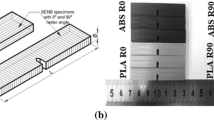Abstract
Fused deposition modeling (FDM) based 3D printing) technique involves the fabrication of polymer parts using a thermal process which may induce residual stress, stress concentration, distortion, and the delamination between layers. This paper aims to investigate this defect on ASTM D638 polymer composite specimens. For that purpose, a 3D thermo-mechanical model that simulates the process of FDM capable of calculating stresses and temperature gradients during the additive manufacturing of polymer composites was developed. The 3D model considers the temperature-dependent physical properties of composites which consist of density, thermal conductivity, thermal expansion coefficient, yield stress, and Young’s modulus. The simulated process includes the heating, solidification, and cooling phases. Different printed parts were analyzed and compared. The stresses vary continuously because of the temperature gradient occurring through the composite thickness. It appears that the concentration of stresses is higher if the temperatures during printing vary rapidly. Those stresses can favor the delamination between the layers of the printed part and the residual thermal stresses can cause an offset to the failure envelope.


















Similar content being viewed by others
References
Mercelis P, Kruth J (2006) Residual stresses in selective laser sintering and selective laser melting. Rapid Prototyp J 12:254–265
Armillotta A, Bellotti M, Cavallaro M (2018) Warpage of FDM parts: experimental tests and analytic model. Robot Comput Integr Manuf 50:140–152
Parandoush P, Lin D (2017) A review on additive manufacturing of polymer-fiber composites. Compos Struct 182:36–53
Massoni E, Silvestri L, Bozzi M, Perregrini L, Alaimo G, Marconi S, Auricchio F (2016) Characterization of 3D-printed dielectric substrates with different infill for microwave applications. In: Advanced materials and processes for RF and THz applications (IMWS-AMP) 1–4
Domingo-Espin M, Puigoriol-Forcada J, Garcia-Granada A, Llumà J, Borros S, Reyes G (2015) Mechanical property characterization and simulation of fused deposition modeling Polycarbonate parts. Mater Des 83:670–677
Zhou Y, Nyberg T, Xiong G, Liu D (2016) Temperature analysis in the fused deposition modeling process. IEEE Comput Soc. https://doi.org/10.1109/ICISCE.2016.150
Costa SF, Duarte FM, Covas JA (2014) Thermal conditions affecting heat transfer in FDM/FFE: a contribution towards the numerical modelling of the process. Virtual Phys Prototyping. https://doi.org/10.1080/17452759.2014.984042
Cattenone A, Morganti S, Alaimo G, Auricchio F (2018) Finite element analysis of additive manufacturing based on fused deposition modeling (FDM): distortions prediction and comparison with experimental data. J Manuf Sci Eng 141:011010. https://doi.org/10.1115/1.4041626
Quelho de Macedo R, Thiago Luiz Ferreira R (2017) Residual thermal stress in fused deposition modelling, 24th edn. ABCM International Congress of Mechanical Engineering, Curitiba
Xia H, Lu J, Dabiri S, Tryggvason G (2018) Fully resolved numerical simulations of fused deposition modeling. Part I: fluid flow. Rapid Prototyp J 24:463–476. https://doi.org/10.1108/RPJ-12-2016-0217
Zhang Y Kevin Chou Y (2006) 3D FEA simulations of fused deposition modeling process. Proceedings of MSEC2006. ASME International Conference on Manufacturing Science and Engineering, Ypsilanti, MI.
Bertevas E, Férec J, Cheong Khoo B, Ausias G, Phan-Thien N (2018) Smoothed particle hydrodynamics (SPH) modeling of fiber orientation in a 3D printing process. Phys Fluids 30:103
Comminal R, Serdeczny M, Pedersen D, Spangenberg J (2018) Numerical modeling of the strand deposition flow in extrusion-based additive manufacturing. Addit Manuf 20:68–76
Heller B, Smith D, Jack D (2016) Effects of extrudate swell and nozzle geometry on fiber orientation in fused filament fabrication nozzle flow. Addit Manuf 12:252–264
Heller BP, Smith DE, Jack DA (2017) Simulation of planar deposition polymer melt flow and fiber orientation in fused filament fabrication. Solid freeform fabrication: proceedings of the 28th annual international solid freeform fabrication symposium – an additive manufacturing conference.
Russell T, Heller B, Jack DA, Smith DE (2018) Prediction of the fiber orientation state and the resulting structural and thermal properties of fiber reinforced additive manufactured composites fabricated using the big area additive manufacturing process. J Compos Sci 2:26
Wang Z, Smith DE (2018) Rheology effects on predicted fiber orientation and elastic properties in large scale polymer composite additive manufacturing. J Compos Sci 2:10
Mohamed OA, Masood S, Bhowmik J (2016) Analytical modelling and optimization of the temperature-dependent dynamic mechanical properties of fused deposition fabricated parts made of PC-ABS. Materials 9:895. https://doi.org/10.3390/ma9110895
https://slic3r.org/. Open source 3D printing toolbox.
Zhang J, Wang X, Wang Yu W, Deng Y (2017) Numerical investigation of the influence of process conditions on the temperature variation in fused deposition modeling. Mater Des 130:59–68
Bejan A (1993) Heat Transfer. Wiley, New York
Costa SF, Duarte FM, Covas JA (2017) Estimation of filament temperature and adhesion development infused deposition techniques. J Mater Process Technol 245:167–179
Yilbas BS, Arif AFM (2001) Material response to thermal loading due to short pulse laser heating. Int J Heat Mass Transf 44:3787–3798
Carlslaw HS, Jaeger JC (1959) Conduction of heat in solids. Oxford University Press, London
Hassoon OH, Tarfaoui M, El Moumen A (2017) Progressive damage modeling in laminate composites under slamming impact water for naval applications. Compos Struct 167:178–190
El Moumen A, Tarfaoui M, Hassoon O, Lafdi K, Benyahia H, Nachtane M (2018) Experimental study and numerical modelling of low velocity impact on laminated composite reinforced with thin film made of carbon nanotubes. Appl Compos Mater 25:309–320
El Moumen A, Tarfaoui M, Lafdi K (2018) Computational homogenization of mechanical properties for laminate composites reinforced with thin film made of carbon nanotubes. Appl Compos Mater 25:569–588
Funding
This work was funded by DGA France (Direction générale de l'armement - Ministry of Defense), MRIS program.
Author information
Authors and Affiliations
Corresponding authors
Additional information
Publisher’s note
Springer Nature remains neutral with regard to jurisdictional claims in published maps and institutional affiliations.
Rights and permissions
About this article
Cite this article
El Moumen, A., Tarfaoui, M. & Lafdi, K. Modelling of the temperature and residual stress fields during 3D printing of polymer composites. Int J Adv Manuf Technol 104, 1661–1676 (2019). https://doi.org/10.1007/s00170-019-03965-y
Received:
Accepted:
Published:
Issue Date:
DOI: https://doi.org/10.1007/s00170-019-03965-y




